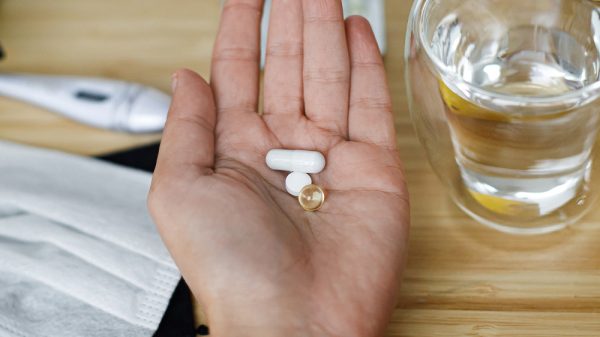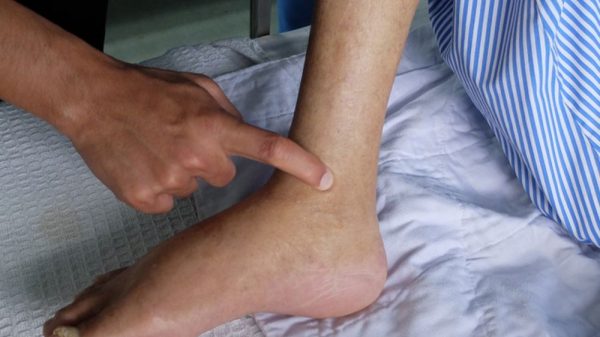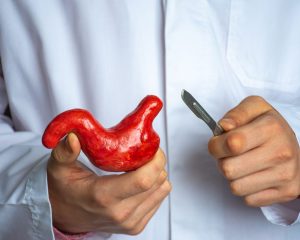Most of the American population doesn’t get enough vitamin D. A deficiency in vitamin D can lead to a vast array of issues ranging from depression to autoimmune diseases. Lacking adequate amounts of vitamin D can also exacerbate heart disease as well as inflammatory conditions like metabolic syndrome and fatty liver disease. How much vitamin D do you need? This article goes through what you need to know about vitamin D and how to get enough to support your health.
What Is Vitamin D?
It’s common knowledge that plants need sunlight to grow and thrive. Well, it turns out that we do too! Vitamin D is a unique vitamin because the body synthesizes it in response to sun exposure. Vitamin D actually isn’t technically a vitamin, but instead, a steroid hormone that is stored in fat cells. When the body synthesizes vitamin D or retrieves it from dietary sources, the original form of vitamin D is inactive. The liver processes this form of vitamin D to produce 25-hydroxyvitamin D. The kidneys are important in converting hydroxyvitamin D into biologically active 1,25-dihydroxyvitamin D.
Vitamin D plays a critical role in modulating DNA expression, fortifying immune response, lowering inflammation, preventing noncommunicable diseases like insulin resistance and fatty liver disease, and even protecting against cancer. Research has shown that deficiency or insufficiency in vitamin D is strongly correlated with autoimmune diseases like multiple sclerosis and lupus. Vitamin D is also important for bone health by regulating the uptake of certain minerals like calcium and phosphorus. We require adequate levels of vitamin D to promote strong bones, maintain bone density, and decrease the risk of bone disorders like osteoporosis.
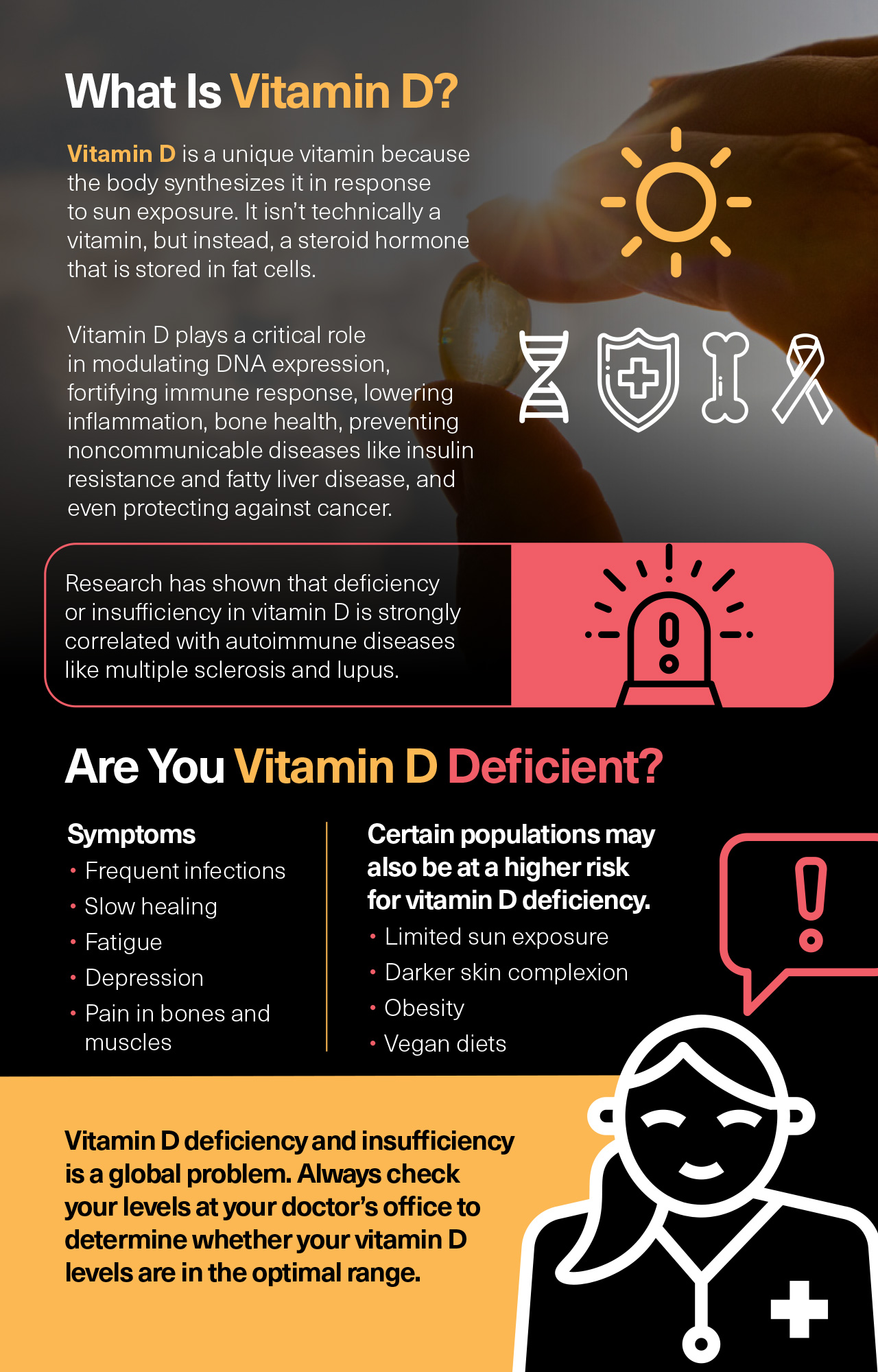
Where Do You Get Vitamin D?
Our bodies synthesize vitamin D in response to sun exposure. Vitamin D is also available in some food sources.
Vitamin D from Sunshine
So why are we all at risk for deficiency? Because, much like plants, we are designed to be outside on a regular basis. For centuries, human beings would work outside farming, hunting, and fishing, with relatively little protection from the elements compared with what we have these days. With the development of electricity and the industrial revolution, working outside gradually became less and less common. Fast forward to the 21st century, a huge portion of the population is stuck in office cubicles, stores, schools, and houses. With the exponential growth of technology, lifestyle has changed drastically, it’s no longer a given that someone will leave the house or office during the day and get sunlight.
On top of that, sun exposure has garnered a terrible reputation as a carcinogen, which has everyone lathering up in SPF 30 sunscreen or higher, which starves our bodies of the ultraviolet rays it requires to synthesize vitamin D in sufficient amounts.
At the same time, it’s important to consider the dangers that the sun poses when it comes to skin cancer. The association between sun exposure and skin cancer is well established, and research has not yet established a “safe” amount of sun you can get without increasing the risk of skin cancer. While getting a few minutes of sun is likely ok, getting hours of sun exposure in the name of vitamin D is not a good idea. It is critical to protect your skin from the sun, especially if you’re prone to burning.
Vitamin D in Food
What about vitamin D in food? There are two types of vitamin D that we generally hear about: ergocalciferol and cholecalciferol, better known as vitamin D2 and vitamin D3. Vitamin D3 is the primary source of vitamin D in animal products, while vitamin D2 is found in plants.
The food sources of vitamin D include fish, egg yolks, dairy products, cereal, and mushrooms. However, the only naturally-occurring food source that contains more than small amounts of vitamin D is fish. Egg yolks and beef liver contain some vitamin D, but not as much as fatty fish. Other foods do not contain a high amount of vitamin D. Yogurt, milk, and cheese are not naturally high in vitamin D and are fortified to help reduce the prevalence and severity of vitamin D deficiency. The only truly “rich” sources of vitamin D are fish. And even then, it depends on the type of fish. Fatty fish like mackerel is particularly high in vitamin D, and so is salmon.
Based on the glaring lack of vitamin D-rich foods, it can be safely assumed that historically, humans have gotten adequate amounts of vitamin D as a result of sun exposure supplemented by foods, and not by regularly downing fish and egg yolks.
Are You Vitamin D Deficient?
The chances are pretty high that you are deficient in vitamin D or at least teetering on the edge. When you get your vitamin D levels checked at your doctor’s office, a lab worker will take a blood sample that will be analyzed for serum levels of 25-hydroxyvitamin D, also known as 25(OH)D. The National Institutes of Health Office of Dietary Supplements provides guidelines for serum levels of vitamin D. (1)
Guidelines assert that blood levels of vitamin D lower than 12 nanograms per milliliter (ng/mL) are insufficient for healthy functioning and cause serious symptoms of deficiency, like rickets. A measurement up to 20 ng/mL is insufficient for healthy functioning, though may not exhibit obvious symptoms. However, measurements between 12 ng/mL and 20 ng/mL may significantly raise your risk for certain diseases. Guidelines suggest that an ideal level of serum vitamin D lies between 20 ng/mL and 50 ng/mL, with vitamin D toxicity potentially occurring at levels above 60 ng/mL. However, many health professionals and researchers dispute this, and clinical parameters usually regard serum vitamin D levels above 32 ng/mL and up to 100 ng/mL as normal. (2)
Without a blood test, it’s hard to know if you’re deficient in vitamin D, since it may produce no symptoms for a very long time. If you do have symptoms of vitamin D deficiency, it may exhibit as:
- Frequent infections
- Slow healing
- Fatigue
- Depression
- Pain in bones and muscles
Certain populations may also be at a higher risk for vitamin D deficiency. (3)
- Limited sun exposure: Living at a latitude that sees very little sunshine may increase the risk of being vitamin D deficient. For example, individuals living in Alaska, Canada, and Northern Europe may see very few (if any) hours of sunlight during the winter. On top of that, the strength of the sun at these latitudes is likely inadequate to promote sufficient vitamin D synthesis.
- Darker skin complexion: Individuals with a darker skin tone require much more sunlight in order to synthesize vitamin D. To synthesize the same levels of vitamin D as a lighter-skinner person, a darker-skinned person must remain in the sun for up to five times longer. (3)
- Obesity: A high body mass index is correlated with lower levels of vitamin D. This is likely associated with the fat-soluble nature of vitamin D. During weight loss, vitamin D stored in excess fat cells is released and increases serum levels of vitamin D. Individuals with a high BMI who are deficient in vitamin D require a higher dose of supplementary vitamin D to reach adequate levels, in comparison to individuals with a lower BMI.
- Vegan diets: Though it’s difficult for the average person to get enough vitamin D through food sources, someone following a vegan diet is even less likely to get sufficient food sources of vitamin D. This is because someone following a vegan diet cuts out the highest food sources of vitamin D, including fatty fish, eggs, and fortified dairy products. The only dietary sources of vitamin D on a vegan diet would be fortified cereal, orange juice, and mushrooms, all of which likely won’t have enough vitamin D to support optimal health. If an individual following a vegan diet also doesn’t get regular sun exposure, the risk of vitamin D deficiency or insufficiency is even higher.
Keep in mind that even if you don’t have any risk factors for vitamin D deficiency, this doesn’t mean that you are not deficient. Vitamin D deficiency and insufficiency is a global problem. Always check your levels at your doctor’s office to determine whether your vitamin D levels are in the optimal range.
How Much Vitamin D Do I Need Daily?
There’s a lot of debate swirling around how much vitamin D you should get from nutritional sources on a daily basis. Currently, common recommendations range from around 400-800 international units (IU) depending on age and gender. This recommendation has been formed under the assumption of very little sun exposure.
However, research challenges this recommendation. A study published in the American Journal of Clinical Nutrition found that in order to maintain adequate levels of serum 25(OH)D without sun exposure, 3800 IU is recommended. For individuals who are below adequate serum levels of 25(OH)D, a daily dose of 5000 IU per day is recommended. (4)
Research also suggests that it may be very difficult to reach toxic doses of vitamin D. A study published in the North American Journal of Medical Sciences found that supplementing with 50,000 to 100,000 IU per week was safe for patients with vitamin D deficiency. (2)
Furthermore, it is interesting to note that research also shows that in response to sufficient sunlight, the body synthesizes 10,000 to 25,000 IU daily. This is a significantly larger dose than what guidelines recommend and suggests that the threshold for vitamin D toxicity and intolerance is actually much higher. (2)
Supplementing with Vitamin D
There is generally no consensus about how much vitamin D supplementation is enough, and how much vitamin D is too much.
Many physicians and health care providers, in response to vitamin D deficiency in adults, recommend supplementing with a daily intake of 5000 IU vitamin D.
Do you need to supplement with vitamin D? It is exceedingly difficult to get enough vitamin D through food sources alone, without sun exposure. So, if you don’t receive any sun exposure or choose to shield your skin from the sun, supplementing is probably the best option. Though it’s extremely difficult to overdose on vitamin D, it’s best to check with your physician to assess your vitamin D levels and determine how much is right for you.
If you decide to add a vitamin D supplement to your regimen, it’s also a good idea to supplement with calcium as well, since both work together to optimize calcium absorption and support healthy bones and organ function.
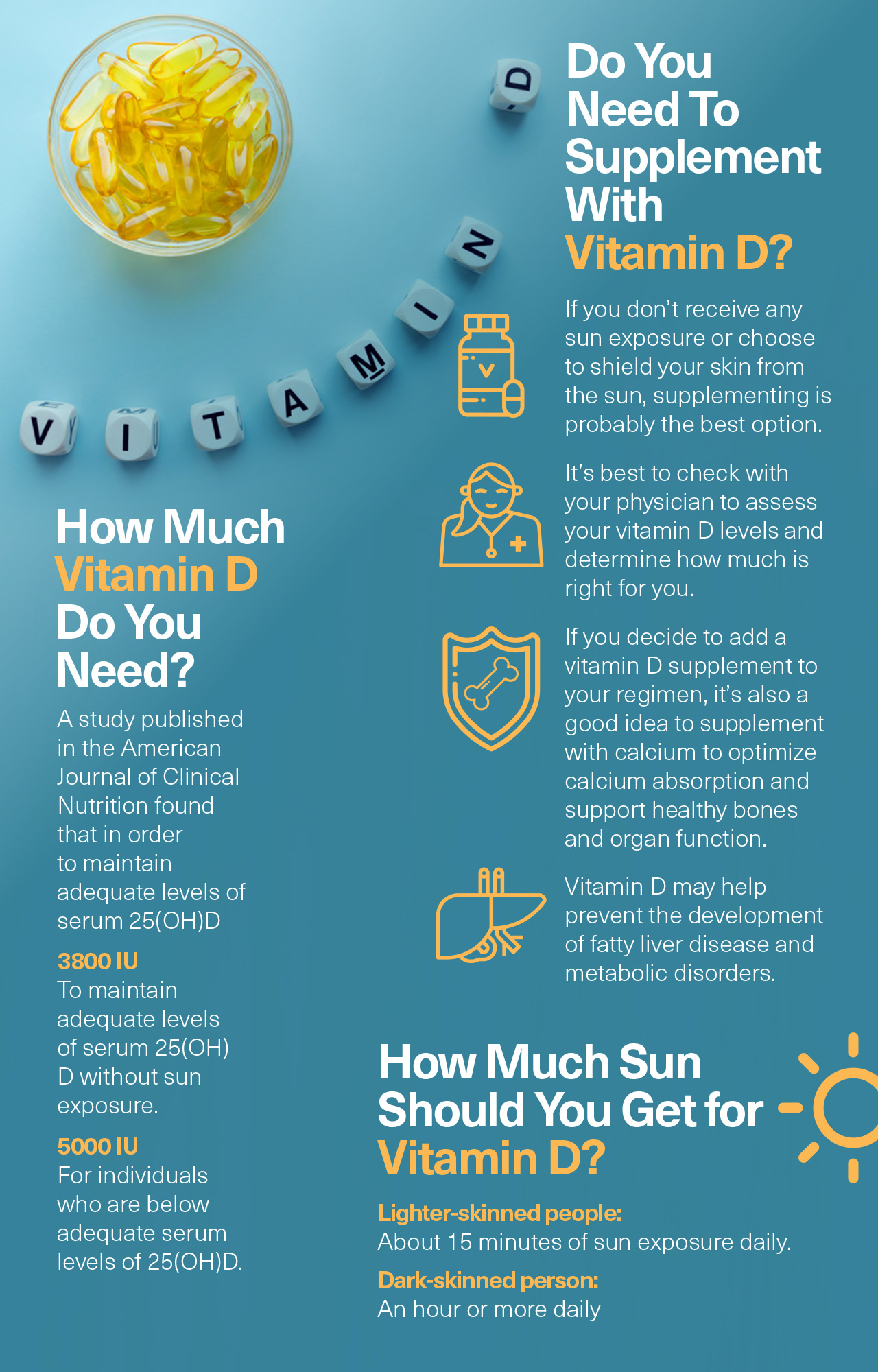
How Much Sun Should I Get?
Lighter-skinned people generally need about 15 minutes of sun exposure per day to synthesize adequate levels of vitamin D. A dark-skinned person may need an hour or more of sun exposure to create the same amount of vitamin D. Dark-skinned people need significantly more sun exposure to synthesize vitamin D than light-skinned people, since the melanin that darkens skin pigmentation also inhibits vitamin D synthesis.
As mentioned above, it’s still critical to protect your skin from excessive sun exposure, especially if you’re prone to burning. In many cases, supplementing with vitamin D may be the best solution for getting sufficient amounts of vitamin D.
Vitamin D and Fatty Liver Disease
Vitamin D may help prevent the development of fatty liver disease and metabolic disorders.
Vitamin D deficiency is often observed with fatty liver disease and obtaining sufficient amounts of vitamin D is important for facilitating liver repair and fighting inflammation. Research published in the World Journal of Gastroenterology assesses the role of vitamin D in preventing nonalcoholic fatty liver disease and conditions like metabolic syndrome. (5)
Why You Should Consider Supplementing with Vitamin D
Getting enough vitamin D each day may be a critical part of reversing fatty liver disease, in addition to a healthy balanced diet. The best diet for reversing fatty liver disease is one that is plant-based; rich in fruits, vegetables, nuts, seeds, beans, and legumes, with a moderate amount of fatty fish and lower amounts of low-fat dairy and meat.
Ironically, even though this diet is proven to reverse fatty liver disease, it may place you at a greater risk of having low vitamin D levels if you don’t get any sun exposure at all. Because vitamin D deficiency is central to many medical conditions, it is worth looking into a high-quality supplement of vitamin D.
You can get vitamin D supplements over-the-counter at your local grocery stores and pharmacies. Generally, vitamin D3 is more effective if you are considering taking high doses of vitamin D. Before starting vitamin D supplementation, consult your physician to get medical advice on how much vitamin D is recommended for your particular health condition.
Energy Levels
Vitamin D seems to be associated with higher energy levels. Having optimal levels of vitamin D fortifies the immune system and regulates metabolism, which can lead to improved, sustained energy levels. Conversely, insufficient levels of vitamin D are associated with fatigue and low energy levels.
A study conducted by researchers at the Cooper Medical School of Rowan University in New Jersey assessed 174 patients who experienced symptoms of fatigue. Researchers found that 77.2% of these patients had low levels of vitamin D. A five-week treatment of vitamin D supplementation resulted in significant improvements in energy levels. (6)
This may have important implications for fatty liver disease, which commonly presents with symptoms of fatigue and exhaustion. Getting a boost of vitamin D may not only directly decrease inflammation associated with fatty liver disease, but it may also directly combat unpleasant symptoms.
Though there’s not much research to make a conclusion, either way, the best time of day to take vitamin D may be the morning since it has been shown to increase energy levels. However, because vitamin D levels build up in your system over time, it’s unlikely that the time of day influences the effect of vitamin D supplements. You could take vitamin D supplements in the evenings and feel the positive effects of sustained energy in the mornings.
To maximize vitamin D absorption, try taking supplements when you eat a meal. Vitamin D is fat-soluble and absorption is highest when it is digested with fat particles.
If you are supplementing or increasing your food intake or sun exposure, give it a few months. Though you may feel the positive effects sooner, it will likely take a few months for vitamin D levels to show an increase in blood tests.
Muscle Synthesis
Vitamin D is especially important in supporting the effective usage of essential amino acids in the body. The benefits of vitamin D are extremely relevant for older adults who may be facing muscle wasting, or sarcopenia. Because vitamin D is classified as a steroid hormone, it promotes muscle synthesis.
Results may be even more pronounced when ideal levels of vitamin D are combined with optimal ratios of essential amino acids. (7) In a randomized controlled trial published in the American Journal of Clinical Nutrition, researchers studied the effects of whey protein, essential amino acids, exercise and vitamin D supplementation on aging adults with sarcopenia. Results revealed that whey protein, essential amino acids, and vitamin D combined with exercise increased lean muscle mass, improved grip strength, and lowered inflammation. (7)
These results may also have implications for older adults with fatty liver disease, who are at a greater risk of experiencing disease progression than younger adults. Essential amino acids are critical to ensuring that older adults maintain adequate muscle mass, healthy immune response, and lower the risk of complications and malnutrition associated with liver disease. Overall, getting all essential amino acids and adequate vitamin D helps older adults heal from disease, increase their strength, and ultimately have a higher quality of life.
The Bottom Line
Vitamin D deficiency and insufficiency is an issue that spans populations worldwide. Vitamin D is a critical nutrient that you get mainly from sun exposure and is less abundant in foods than many other critical nutrients that we require. Based on research, vitamin D seems to regulate nearly all disease systems and optimal amounts of vitamin D are necessary to decrease the risk of fatty liver disease, metabolic syndrome, and all inflammatory diseases. Vitamin D may even work in concert with essential amino acids to promote muscle synthesis and strength among aging adults, leading to a higher quality of life.
References:
(1) https://ods.od.nih.gov/factsheets/Vitamin%20D-HealthProfessional/#en1
(2) https://www.ncbi.nlm.nih.gov/pmc/articles/PMC4821095/
(3) https://www.ncbi.nlm.nih.gov/pmc/articles/PMC3356951/
(4) https://www.ncbi.nlm.nih.gov/pubmed/18541590
(5) https://www.ncbi.nlm.nih.gov/pmc/articles/PMC4323447/
